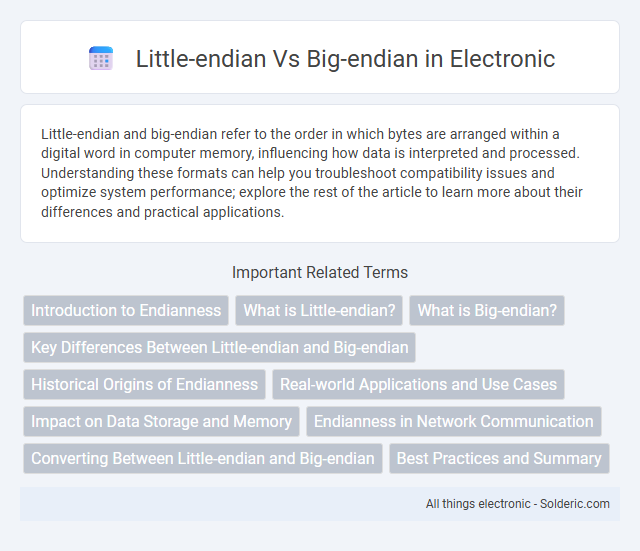Little-endian and big-endian refer to the order in which bytes are arranged within a digital word in computer memory, influencing how data is interpreted and processed. Understanding these formats can help you troubleshoot compatibility issues and optimize system performance; explore the rest of the article to learn more about their differences and practical applications.
Comparison Table
| Aspect | Little-endian | Big-endian |
|---|---|---|
| Byte Order | Least significant byte stored at lowest memory address | Most significant byte stored at lowest memory address |
| Memory Addressing | Low to High: LSB to MSB | Low to High: MSB to LSB |
| Common Architectures | x86, x86-64, ARM (in Little-endian mode) | SPARC, PowerPC (in Big-endian mode), IBM mainframes |
| Use Case | Widely used in personal computers and servers | Network protocols, some RISC architectures |
| Data Interpretation | Simple increment index from lowest byte | Data read naturally as human-readable hex |
| Endianness in Networking | Requires conversion to network byte order (Big-endian) | Same as network byte order |
Introduction to Endianness
Endianness defines the order in which bytes are arranged within a digital word when stored in memory, with little-endian systems placing the least significant byte first and big-endian systems storing the most significant byte first. This byte order impacts data interpretation across different hardware architectures and network protocols, influencing software compatibility and performance. Understanding endianness is crucial for developers working with low-level data manipulation, cross-platform communication, and system interoperability to ensure your applications correctly process multi-byte values.
What is Little-endian?
Little-endian is a byte order format where the least significant byte (LSB) is stored at the smallest memory address, making it the first byte read in memory. This format is commonly used in x86 and x86-64 computer architectures, enabling efficient processing of multi-byte data types such as integers and floating-point numbers. Little-endian storage simplifies arithmetic operations by allowing the system to access the least significant part of the data directly from the base address.
What is Big-endian?
Big-endian is a byte order format where the most significant byte (MSB) of a data word is stored at the lowest memory address, followed sequentially by the less significant bytes. This convention is used in network protocols like TCP/IP, ensuring consistency in data interpretation across different systems. Big-endian contrasts with little-endian, where the least significant byte (LSB) is stored first, impacting data serialization and interoperability in computing environments.
Key Differences Between Little-endian and Big-endian
Little-endian stores the least significant byte at the lowest memory address, while Big-endian stores the most significant byte first, affecting data interpretation across systems. This difference impacts byte ordering in multi-byte data types such as integers and floating-point numbers, influencing compatibility and performance in software and hardware interactions. Understanding these variations ensures correct data processing when transferring information between platforms with differing endianness.
Historical Origins of Endianness
The historical origins of endianness trace back to early computer architecture decisions in the 1960s, particularly between DEC's PDP-11, which used little-endian format, and IBM's System/360, which adopted big-endian format. These differing byte orders reflect the contrasting design philosophies and hardware implementations of the time, influencing how multi-byte data is stored and processed in memory. Understanding these origins provides insight into legacy system compatibility and the evolution of data serialization standards.
Real-world Applications and Use Cases
Little-endian format is commonly used in x86 and x86-64 architectures, making it the standard for most personal computers and servers, while big-endian format is prevalent in network protocols such as TCP/IP and in specialized hardware like IBM mainframes and certain RISC processors. Embedded systems often choose endianness based on performance requirements, communication standards, or legacy compatibility, influencing data serialization and interoperability across platforms. Understanding the endianness of a system is crucial for developers working on cross-platform applications, data transmission, and low-level programming involving memory management or binary file formats.
Impact on Data Storage and Memory
Little-endian and big-endian formats significantly influence data storage and memory organization by determining the byte order of multi-byte values. In little-endian systems, the least significant byte is stored at the lowest memory address, enhancing compatibility with certain processors like x86 architectures, whereas big-endian stores the most significant byte first, common in network protocols such as TCP/IP. Understanding endianess is crucial for cross-platform data exchange and memory alignment optimization, affecting performance and software interoperability.
Endianness in Network Communication
Endianness in network communication refers to the byte order used to represent multi-byte data across different systems, where Big-endian (network byte order) is the standard for transmitting data to ensure consistency. Network protocols like TCP/IP use Big-endian to avoid discrepancies between little-endian architectures like x86 and other systems. Proper handling of endianness is crucial to maintaining data integrity during transmission and interpreting protocol headers accurately.
Converting Between Little-endian and Big-endian
Converting between little-endian and big-endian involves reversing the byte order of multi-byte data types to ensure proper interpretation across different systems. You can achieve this by swapping the positions of bytes in the data, typically using bitwise operations or specialized functions tailored for endianness conversion. Proper handling of this conversion is crucial for data integrity in network communication, file storage, and cross-platform applications.
Best Practices and Summary
Best practices for handling little-endian and big-endian formats emphasize consistent use of a single endianness within a system or protocol to avoid data misinterpretation. Network protocols typically adopt big-endian (network byte order) for standardization, while many modern processors like x86 use little-endian internally, so converting between formats during data transmission is crucial. Summary highlights that understanding the target environment and ensuring proper byte order conversions are key to reliable cross-platform data exchange and system interoperability.
Little-endian vs Big-endian Infographic

 solderic.com
solderic.com